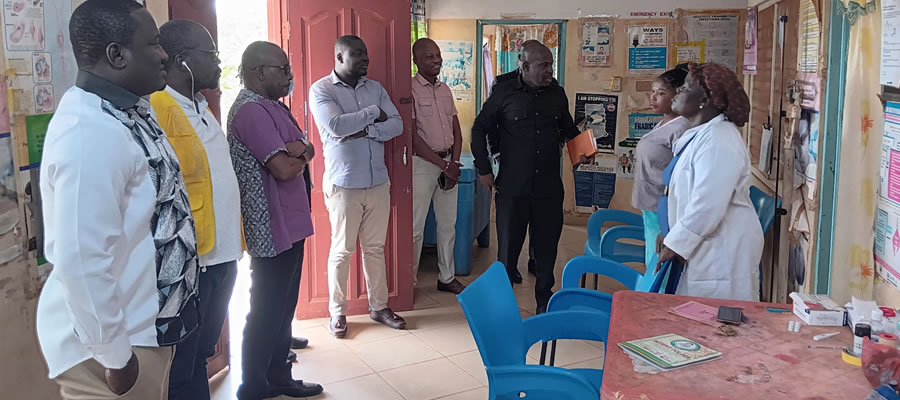

The health services in the district are tailored towards integrated, preventive and curative services with emphasis on primary health care.
The main services provided are;
General medical care
Maternal and child health care and family planning
Nutrition and health education
Environmental health care
Disease control
The district has a hospital and other health institutions include:
Two Health Centres at Mpasaso and Sabronum,
Six (6) Clinics at Domiabra, Wioso, Pokukrom, Dwenewoho, Anitemfe, Essienkyem and Adugyama.
One (1) Maternity Homes at Assibey-Nkwanta and an orthopaedic centre at Kunsu. Health infrastructural facilities in these institutions are in fairly good conditions. Additional facilities are however required.
Access to Health Facilities
Access in Ghana, implies either the ability to reach a health facility within one hour of travel time or location within 8km of a facility. As a result, the health institutions are inadequate for effective health delivery. Several remote communities for example, Mpasaso Dotiem, Bonkwaso 1 & 2, Abasua etc lack easy access to basic health services. Inhabitants in these communities travel more than 15km before they reach a health facility. However, the Community Health Service Planning (CHPS) being implemented, coupled with the introduction of District Mutual Health Insurance Scheme (DMHIS), access to health services has improved significantly.
Personnel
The district has one doctor and 20 hospital beds. This gives doctor-patient ratio of 1:160,495 as compared to the regional ratio of 1:11,818. This impact negatively on the quality of medical services. The paramedical staffs are:-
3 Nurses (General)
2 Medical Assistants
6 Midwives
13 Nurses (CHN)
2 public health nurses
1 Disease Control Officer
8 ward maids/assistants
31 T.B.As
Accommodation is the main problem facing health personnel.
Diseases
The disease pattern in the district is the same as that of other parts of the region. There is high incidence of malaria, infectious disease, diarrhoea, respiratory, tract infection and pregnancy related diseases. Malaria is the most prevalent disease in the district.
Bilharzia is dominant among boys between 7 and 16 years though it is not shown in health records-an indication that the patients do not report for treatment in health centers. Just as in other parts of the country, Malaria is the dorminant disease in the district. (table 24) The underlying causes of common diseases are:
Poor coverage of health delivery system (both i.e. Curative and PHC)
Unsanitary living conditions resulting from inadequate solid and liquid waste disposal facilities and poor personal hygiene.
Certified community –based data have been gathered to provide current figures for maternity and morbidity rate. However, it is generally acknowledged that child and maternal mortality rates are relatively high especially in the remote areas where socio-economic conditions are very hash.
The high childhood mortality rate is due to the prevalence of avoidable and parasitic diseases as major causes of death in the age group of 0-5 years. Enhancing the health situation of the populace, especially the vulnerable would call for appropriate inter sectoral interventions. The high incidence of preventable diseases in the district could be greatly reduced through improved sanitation, increased access to clean, safe drinking water, health education and access to simple medical care.
Nutrition
Malnutrition and malnourishment remain a major health problem in the district for women and children susceptible in society. Information on nutrition is very scanty. Notwithstanding, empirical evidence reveals an unacceptable level of malnutrition and under nourishment in most households in the district. Household survey conducted in 10 communities showed that a sizeable number of households are malnourished.
Pregnant and lactating mothers in particular have been identified as those with poor nutritional status. The commonest type of malnutrition is protein energy malnutrition (PEM), anaemia and vitamin A deficiency. The nutritional problem in the district is more of seasonal phenomenon. A combination of several factors is responsible for low nutritional status of the majority of the inhabitants.
Food shortage especially in the pre-harvest season i.e. around May.
Low i.e. not having income to buy enough food. The level of real household income determines their ability to buy food requirements.
Households must have enough income to acquire adequate quantities. Low agricultural production leads to low income, which makes it impossible for many households to purchase from other sources to supplement household food requirement. Other causes of malnutrition include large family size increasing cost of living, dwindling incomes, and limited maternal nutritional awareness resulting in faulty feeding practices.
Iodated Salt
Market and household survey for iodated salt were conducted in 2001. Thirty (30) salt samples were taken from salt sellers in six (6) markets using systematic random sampling. All the salt samples tested passed with 100%. In the household survey the same thirty (30) salt samples were tested and only 25(83.3%) passed and 5(16.7%) failed.
In April 2002 the survey was repeated but 48 salt samples were tested from the six (6) markets and 87.5% passed. The study further revealed that only 2 markets were selling iodated salt and the other four (4) markets were selling both the iodated and non-iodated salts.
People Living With HIV/AIDS
There is scanty data on the rate of prevalence of HIV/AIDS in the district. The little available records at D. M. O. H. indicate that 11 persons have been tested HIV positive in the district. Even though, the prevalent rate is not yet known, the district is relentlessly pursuing a number of programmes to prevent the spread of HIV/AIDS pandemic. Currently the awareness rate is estimated at 65%. Such programmes include:
Awareness creation
Care and support
Prevention and treatment
Promotion of condom use
Date Created : 11/15/2017 8:27:38 AM










 facebook
facebook
 twitter
twitter
 Youtube
Youtube
 +233 593 831 280
+233 593 831 280 0800 430 430
0800 430 430 GPS: GE-231-4383
GPS: GE-231-4383 info@ghanadistricts.com
info@ghanadistricts.com Box GP1044, Accra, Ghana
Box GP1044, Accra, Ghana